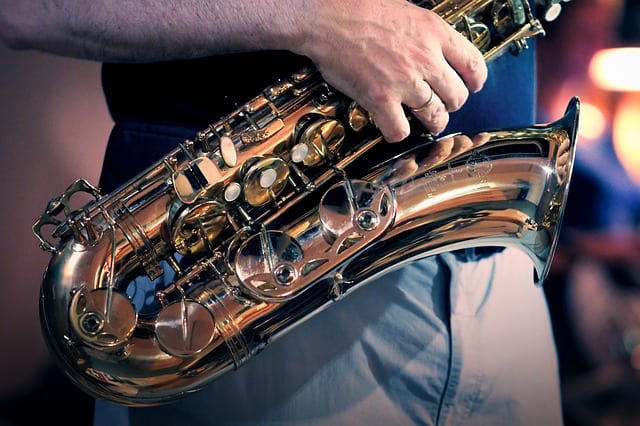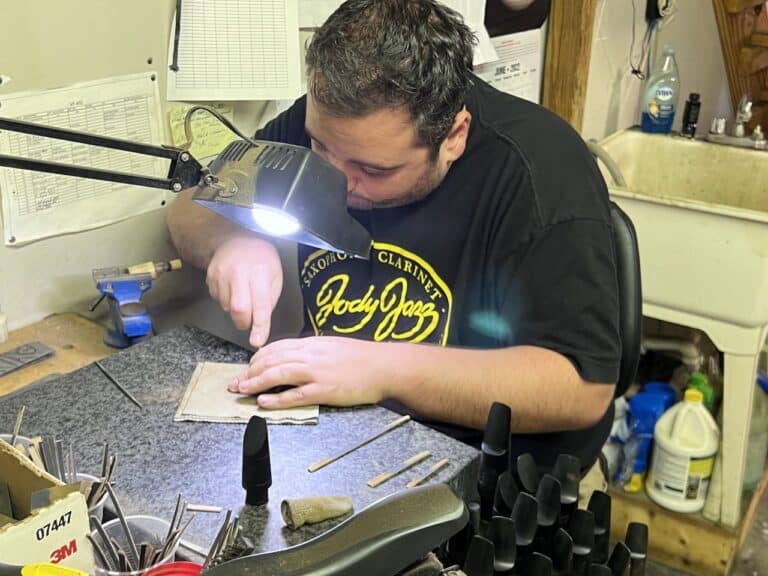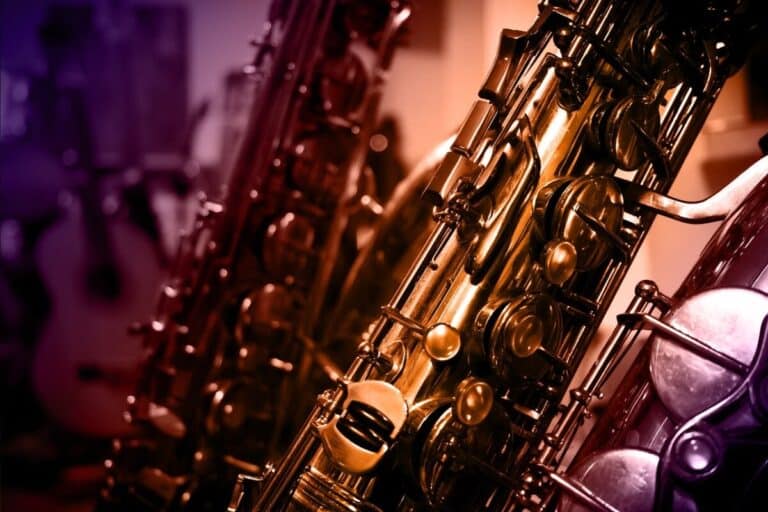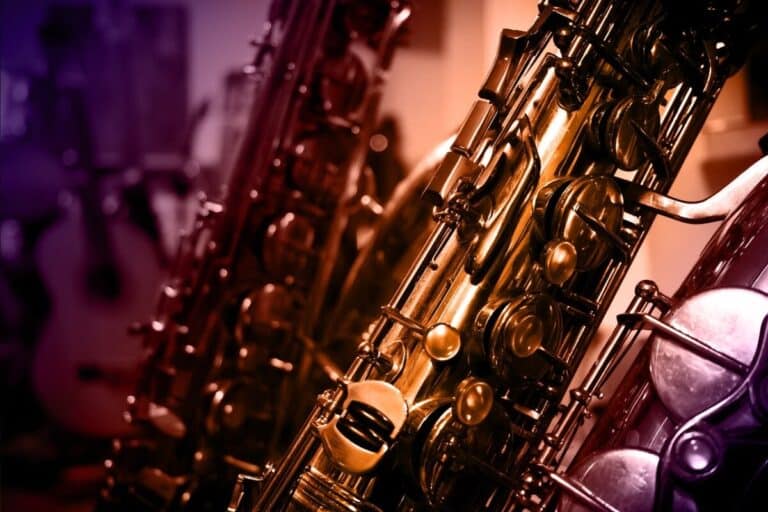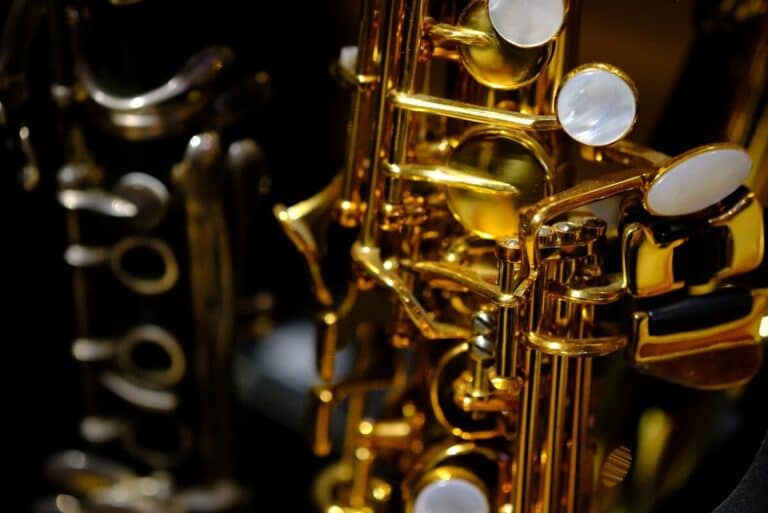How Many Keys are on a Saxophone?
If you’ve ever seen a saxophone before, then you know that it has a seemingly large number of keys compared to your typical brass instrument with only three valves. You may have wondered just how many buttons the saxophone has, and that’s the question that I’ll be answering today.
So, how many keys are on a saxophone? Most professional and intermediate saxophones have 22 keys, but two of the keys (front F and high F#) may not be present on beginner saxophones. Baritone saxophones also tend to have an extra key for low A. So beginner saxophones have 20 keys, intermediate and professional saxophones have 22, and professional baritone saxophones have 23 keys.
You may be wondering why the saxophone needs to have so many keys, especially since many of them seem to be rarely used. Stick with us, and you’ll understand both why the saxophone has so many keys and what each key is used for.
Why does the saxophone have so many keys?
At first, it may seem strange that the saxophone would need to have so many different keys. A saxophone, after all, uses essentially the same fingerings as a recorder, which only needs nine tone holes.
There are several differences between the two instruments which necessitate that the saxophone has so many additional keys. First, the saxophone was designed to be a flexible instrument that is capable of allowing the musician to play fast passages with dexterity. This means that it needs alternate fingerings to avoid any situations for which the technique might otherwise be awkward, hence the creation of more keys.
For instance, the saxophone has about four different ways to play the pitch Bb. This isn’t simply redundant; each of those fingerings have circumstances where they are clearly more useful than the other Bb fingerings. Having different ways to play various pitches gives the musician more flexibility to play difficult passages.
Second, the saxophone has a relatively wide range compared to an instrument such as a recorder, and needs additional keys to cover the high and low notes. So additional keys need to exist to accommodate a larger range.
What do each of the keys do?
Every key of the saxophone is necessary either for the basic functioning or improved versatility of the saxophone. Some are clearly more important than others, but they are all useful in some respect.
The six front pearl keys, bis, and the octave key
These are the six keys which the saxophonist will nearly always have their fingers on, since they are used the most out of any keys. The covering on these keys are called “pearls” because they closely resemble the appearance of pearls. The fingerings involving these keys are much the same as those for the recorder.
Directly underneath the top front pearl key is a smaller pearl key referred to as “bis.” This key serves only one purpose, which is that it produces a Bb when combined with the top pearl key. This is one of four standard Bb fingerings which are typically used on the saxophone.
While I’m at it, I should also mention the octave key, which can be found on the back of the saxophone by the left thumb. Pressing this key bumps the pitch up an octave higher for most fingerings, and is used to access the highest notes of the saxophone.
Using just these eight keys, you can play a few simple scales on the saxophone, such as the C major scale, the F major scale, and the G major scale. However, you would only be able to play each of these scales in a single octave, and you would not be able to play any other scales. To accomplish more than this, we need other keys.
The Eb and low C keys
These two keys fall underneath the pinky of the right hand. The uppermost key in the image is the Eb key, while the lower key is for low C (as well as other lower notes). Notice from the image that there are rollers between them so that the pinky can easily slide from one key to the other; this is meant to make the musician’s life easier during scales and moving passages.
The Eb key serves the sole purpose of allowing the saxophone to play the pitch of Eb (aka D#). It may seem silly that the saxophone has keys that are used for only a single note, but it is nonetheless necessary to have, as otherwise the saxophone would have a gap in its range.
The low C key is necessary for every pitch of low C# and below (I refer to it as the ‘low C’ key because there is an additional key which serves the sole purpose of adjusting from low C up to low C#). So, this key is used for low C#, low C, low B, and low Bb. Having the low C key extends our range and allows us to play some scales, such as the C major scale, in two octaves.
The side keys
Five of these lie underneath the right hand. The one at the top is used for some high notes, and we’ll cover this one later. Beneath that is a key used for “side C,” which is an alternate way of playing a C in two different C. This fingering is primarily used for either the chromatic scale or trilling between B-natural and C.
Beneath the side C key is another key which is used for one specific pitch. This key is used to play a “side Bb,” which is one of the four standard Bb fingerings on the saxophone. Side Bb is largely a fingering used in the chromatic scale or for trilling between A and Bb.
The small oval-shaped key is used for exclusively to play an alternate fingering of F#. Once again, this fingering is used largely for the chromatic scale and for trilling between F and F#.
Beneath that is rectangular key used solely to play a high F#, the highest pitch that the saxophone can play without going into the altissimo range. Beginner models of saxophones may not include this key, since beginners may not typically need to play all the way up to a high F#.
The palm keys
Now we’re getting into the high notes. The first of these, falling right beneath the knuckle of the index finger, is used for high D, as well as the pitches above that. In the French system of labelling saxophone keys, this key is sometimes referred to as “c1.” Using the octave key and c1 will produce a high D.
The palm key next to and slightly above c1 is called “c2.” Combining it with the octave key and c1 will produce a high Eb.
The other palm key next to c2 is actually called “c4.” The reason for this is because “c3” is in a different location, and is in fact the key which falls directly above side-C, which we mentioned earlier. Adding c3 to the octave key, c1, and c2 will produce a high E. Adding c4 will produce a high F, and adding the high F# key (mentioned earlier) will produce a high F#.
The spatula keys
This is a cluster of keys which lies underneath the left pinky. All of these keys are meant to be accessed by the left pinky. The first of these keys, which the pinky typically rests on, is referred to as the “G#” key. Predictably, it is used only to play the pitch of G#.
Beneath that is the low C# key, used to raise a low C up a half step to a C#. Directly adjacent to that is the low B key, which lowers the low C to a B instead of raising it. The lowest key in this cluster is the low Bb key, which lowers the C even further to a Bb.
Front F
This is another key which is sometimes not included on beginner models of saxophones. It is used exclusively as an alternate way of playing the highest notes on the saxophone. This key can be used to produce a high E, a high F, and a high F# without using any of the palm keys. Even so, it is more difficult to produce high notes this way than it is with the palm keys, so this key is often not used by beginners.
Low A
This is a key which is only found on baritone saxophones. If combined with the fingering for a low C (or any pitch lower than that) it produces a low A. This key is found by the left thumb, underneath the octave key on the back of the saxophone.
Related questions
What are the keys on a saxophone called? Typically, they are simply referred to as “keys.” The pearl-like coverings which are on top of many of the main saxophone keys are called “pearls.”
What is the highest note on the alto sax? For most intermediate or professional saxophones, the highest note is the F# above the staff. On some beginner saxophones, the highest note may be the F directly below that.


